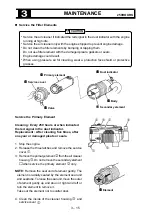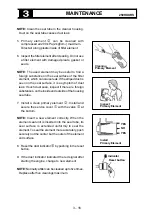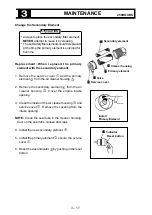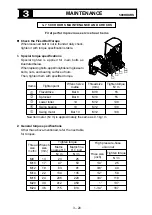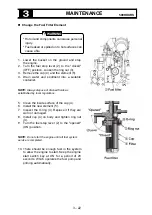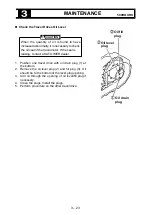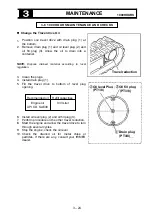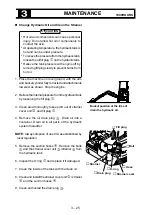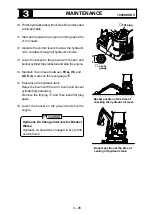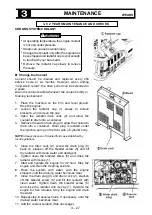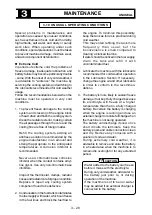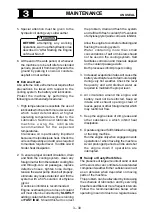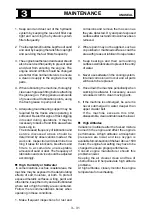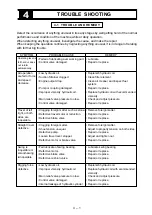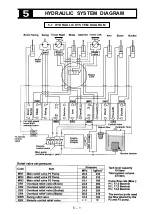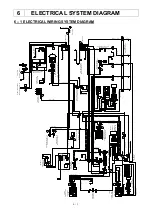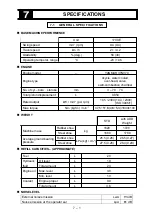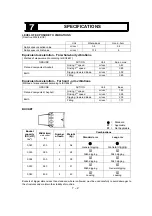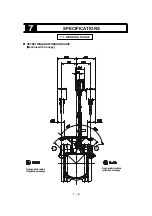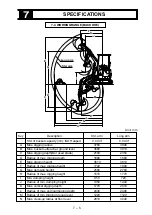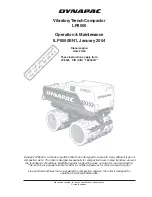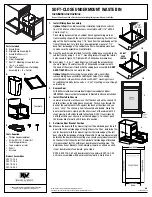
3 – 29
MAINTENANCE
3-10 UNUSUAL OPERATING CONDITIONS
Special problems in maintenance and
operation are caused by unusual conditions
such as extremes in heat, cold and humidity,
high altitude, salt water, and dusty or sandy
work sites. When operating under such
conditions, special precautions must be taken
to prevent machine damage, minimize wear,
and avoid component deterioration.
Extreme Cold
In periods of extreme cold, the problems of
freeze damage, inadequate lubrication and
battery failure may become particularly trouble
- some. With the onset of very cold weather, it
is advisable to "winterize" the machine by
servicing the cooling system and switching to
the lubricants recommended for cold weather
usage.
Follow the recommendations below when the
machine must be operated in very cold
conditions.
1. To prevent freeze damage to the cooling
system and cracking of the engine block
or head, drain and flush the cooling system.
Clean the radiator exterior, making certain
the air passages through the core and the
cooling fins are free of foreign matter.
Refill the cooling system, adding an
antifreeze solution recommended by the
engine manufacturer in an amount and
strength appropriate to the anticipated
temperatures. A corrosion inhibitor is
recommended.
Never use a chromatic base corrosion
inhibitor when the coolant contains ethyl-
line glycol. Use only non-chromatic base
inhibitors.
Inspect the thermostat, clamps, radiator
hoses and radiator core for proper condition.
Replace or repair any cooling system
component found to be defective.
2. Condensation in the fuel tank contaminates
the fuel supply with water, which can freeze
in the fuel lines and block the fuel flow to
the engine. To minimize this possibility,
keep the tank as full as is practical during
cold weather.
This may entail refilling the tank more
f r e q u e n t l y t h a n u s u a l , b u t t h e
inconvenience is small compared to
clearing a blocked fuel line.
If water should be noticed in the fuel supply,
drain the tank and refill it with
uncontaminated fuel.
3. Lubricate the machine with the lubricants
recommended for cold weather operation
in the Lubrication Section. If necessary,
change the engine oil and other lubricants
in order to conform to the recommen-
dations.
4. The battery is more likely to sustain freeze
damage if not kept fully charged because
its electrolyte will freeze at a higher
temperature than that in a fully charged
battery. Be certain the battery is charging
when the engine is running and use an
external charger to restore full charge when
the machine is not being operated.
The battery can discharge if snow or ice
short circuits the terminals. Keep the
battery posts and cable connectors clean
and dry. Remove any corrosion with a
solution of soda and water.
During extremely cold weather, it is
advisable to remove and store the battery
in a heated area when the machine is to
remain idle overnight or for any extended
period.
Water added to the battery can freeze
before it mixes with the electrolyte.
During very cold weather, add water to
the battery just prior to, or during
operation of the machine.
If the machine is not to be run. water
may be added if an external charger is
connected to the battery.
CAUTION
UNUSEAL
Summary of Contents for 17VXE
Page 2: ......
Page 62: ...2 1 8 ...
Page 110: ...5 1 HYDRAULIC SYSTEM DIAGRAM 5 1 HYDRAULIC SYSTEM DIAGRAM 2 9 30 ...
Page 118: ...MINI EXCAVATOR 17VXE PUBLISHED MARCH 2017 KATO IMER S p A ITALY ...
Page 119: ......
Page 120: ......

